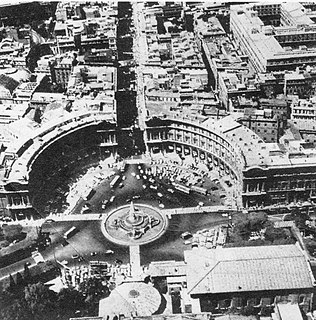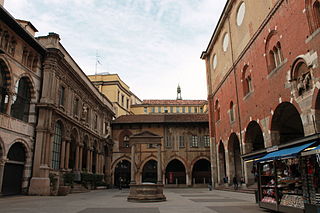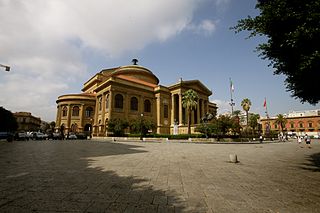Piazza Castelnuovo is a square of Palermo. Along with the contiguous Piazza Ruggero Settimo, it forms a single urban space, commonly called Piazza Politeama, by virtue of the presence of Teatro Politeama, the second most important theatre of the city after Teatro Massimo. The square is located between Via Ruggero Settimo, Viale della Libertà and Via Dante, near the historic centre of Palermo, and represents one of the most popular city's square.

Palermo is a city of Southern Italy, the capital of both the autonomous region of Sicily and the Metropolitan City of Palermo. The city is noted for its history, culture, architecture and gastronomy, playing an important role throughout much of its existence; it is over 2,700 years old. Palermo is located in the northwest of the island of Sicily, right by the Gulf of Palermo in the Tyrrhenian Sea.

Piazza Ruggero Settimo is a square of Palermo. Along with the contiguous Piazza Castelnuovo, it forms a single urban space, commonly called Piazza Politeama, by virtue of the presence of Teatro Politeama, the second most important theatre of the city after Teatro Massimo. The square is located between Via Ruggero Settimo and Viale della Libertà, near the historic centre of Palermo, and represents one of the most popular city's square.

The Politeama Theatre is a theatre of Palermo. It is located in the central Piazza Ruggero Settimo and represents the second most important theatre of the city after the Teatro Massimo. It houses the Orchestra Sinfonica Siciliana.
On Piazza Castelnuovo are located a structure called "Palchetto della Musica" (work of Salvatore Valenti), the monument to Carlo Cottone (work of Giovan Battista Palazzotto and Domenico Costantino), the sculptures "Nautica" (work of Mario Rutelli), "Lavoro" (work of Benedetto Civiletti) and "Senzatetto" (work of Pasquale Civiletti).

Carlo Cottone, prince of Castelnuovo, was a Sicilian politician, known as one of the main advocates of the Sicilian Constitution of 1812.

Mario Rutelli was an Italian sculptor.
The square is named after Carlo Cottone, prince of Castelnuovo, one of the advocate of the Sicilian Constitution of 1812.
This page is based on this
Wikipedia article Text is available under the
CC BY-SA 4.0 license; additional terms may apply.
Images, videos and audio are available under their respective licenses.

Ruggero Leoncavallo was an Italian opera composer and librettist. Although he produced numerous operas and other songs throughout his career it is his opera Pagliacci (1892) that remained his lasting contribution, despite attempts to escape the shadow of his greatest success.
The Music of Sicily refers to music created by peoples from the isle of Sicily. It was shaped by the island's history, from the island's great presence as part of Magna Grecia 2,500 years ago, through various historical incarnations as a part of the Roman Empire, then an integral part of the Kingdom of Sicily, and, finally, as an autonomous region of the modern nation state of Italy.

The Teatro Massimo Vittorio Emanuele is an opera house and opera company located on the Piazza Verdi in Palermo, Sicily. It was dedicated to King Victor Emanuel II.
It is the biggest in Italy, and one of the largest of Europe, renowned for its perfect acoustics.

Piazza della Repubblica is a semi-circular piazza in Rome, at the summit of the Viminal Hill, next to the Termini station. On it is to be found Santa Maria degli Angeli e dei Martiri. It is served by the Repubblica – Teatro dell'Opera Metro station. From the square starts one of the main streets of Rome, Via Nazionale.

Turin is a city and an important business and cultural centre in northern Italy. It is the capital city of the Metropolitan City of Turin and of the Piedmont region, and was the first capital city of Italy from 1861 to 1865. The city is located mainly on the western bank of the Po River, in front of Susa Valley, and is surrounded by the western Alpine arch and Superga Hill. The population of the city proper is 878,074 while the population of the urban area is estimated by Eurostat to be 1.7 million inhabitants. The Turin metropolitan area is estimated by the OECD to have a population of 2.2 million.

Piazza Mercanti is a central city square of Milan, Italy. It is located between Piazza del Duomo, which marks the centre of the modern city of Milan, and Piazza Cordusio, and it used to be the heart of the city in the Middle Ages. At the time, the square was larger than it is now and known as "Piazza del Broletto", after the "Broletto Nuovo", the palace that occupied the centre of the square. In the 13th century, there were six entry points to the square, each associated to a specific trade, from sword blacksmiths to hat makers.

Piazza d'Aracoeli is a square of Rome (Italy), placed at the base of the Capitoline Hill, in the Rione X Campitelli.

Paolo Restani is an Italian classical pianist.
Gemma Bosini was an Italian operatic soprano who had an active international performance career from 1909–1930. She is especially associated with the role of Alice Ford in Giuseppe Verdi's Falstaff, a role which she performed more than 400 times on stage during her career. She is also remembered for being the first soprano to record the role of Mimi in Giacomo Puccini's La boheme in 1917. She also made complete recordings of Gounod's Faust and Lehar's The Merry Widow. After retiring from performance in 1930, she devoted herself to teaching singing and managing the career of her husband, baritone Mariano Stabile.
Ayres Borghi-Zerni was an Italian operatic soprano who had a distinguished international career from 1914 till 1928.

The Church of Saint Dominic is a church in Palermo, Sicily, southern Italy. It is located in Piazza San Domenico, in the quarter of La Loggia, within the historic centre of the city. The church hosts the burials of many figures of Sicilian history and culture. For this reason it is known as the "Pantheon of illustrious Sicilians".

Via Maqueda, also known as "Strada Nuova", is an important street of Palermo. Together with the Cassaro, it represents the main axis of the historic centre and provides access to a number of important sights, including Teatro Massimo and Fontana Pretoria. The street is named after the Viceroy of Sicily Bernardino de Cárdenas y Portugal, Duque de Maqueda.

Via Roma is an important street of Palermo. It represents one of the main axes of the historic centre and connect the Palermo Centrale railway station to the Teatro Politeama. Several important buildings of the city appears along the street's path. Via Roma was designed with the 1885 Master Plan of Palermo and built between 1894 and 1936.

Piazza Verdi, commonly known as Piazza Massimo, is a square of Palermo. At its centre is the somptuous Teatro Massimo, the biggest opera house of Italy, and the third of Europe after the Opéra National de Paris and the K. K. Hof-Opernhaus in Vienna. The square is located in the heart of the city, near the central Via Maqueda, in the quarter of the Seralcadio, within the historic centre of Palermo.

The following outline is provided as an overview of and topical guide to Palermo:





















